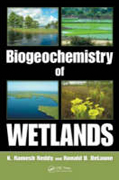
Biogeochemistry of wetlands: science and applications
Reddy, K. Ramesh
Delaune, Ronald D.
About a fourth of the plants, half of the fish, two-thirds of the birds, and three-fourths of the amphibians categorized as threatened or endangered in theUnited States are associated with wetlands. These areas can help control flooding, reduce wave action, slow down the flow of water, and improve water quality. Covering freshwater and coastal wetlands and their role in global climate change, "Biogeochemistry of Wetlands" is the first comprehensive book on biogeochemical cycling in these critical habitats. It offers an in-depth look at the chemical and biological cycling of nutrients, trace elements, and toxic organic compounds in wetland soils and water. INDICE: Introduction. Basic Concepts and Terminology. Biogeochemical Characteristics of Wetlands. Electrochemical Properties. Carbon. Oxygen. Adaptationof Plants to Soil Anaerobiosis. Nitrogen. Phosphorous. Biogeochemistry of Iron and Manganese. Sulfur. Metals/Metalloids. Toxic Organic Compounds. Soil and Floodwater Exchange Processes. Biogeochemical Indicators. Wetlands and Global Climate Change. Freshwater Wetlands: The Everglades. Coastal Wetlands: Mississippi River Deltaic Plain Coastal Marshes, Louisiana. Advances in Biogeochemistry. References. Index.
- ISBN: 978-1-56670-678-0
- Editorial: CRC Press
- Encuadernacion: Cartoné
- Páginas: 774
- Fecha Publicación: 01/08/2008
- Nº Volúmenes: 1
- Idioma: Inglés
